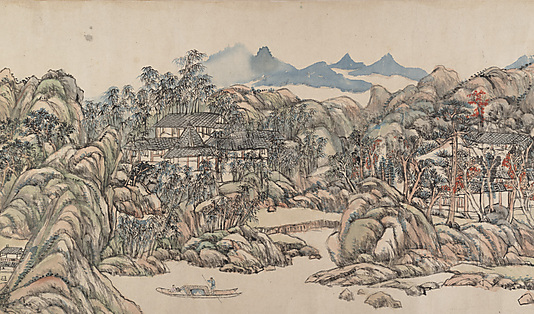The Chinese word for landscape is “shanshui”, which literally means mountains and water.”
It is traditional to think of focal points in a landscape as statues, sculpture, topiary, buildings, follies, water features or plant specimens. But what about topographic foci?
For centuries in Chinese landscape art, mountains (and water) were the emphasis in the landscape. And likewise this was also the emphasis in Chinese landscape design, whether in a large landscape or small garden design.
Rocks and boulders were and still are representative of these features. They provide the same or similar vertical emphasis that a statue, building or folly would, but with a more naturalistic “unbuilt” form.
They are not only foci, but also destination points along a journey. A strong contrast to the level or lower-lying ground plane.
Similarly a “bowl” which is an inversion or depression in the groundplane is at direct contrast with a mounded vertical feature.
In a depression, people are naturally and psychologically attracted to discover the mystery within and then ultimately ascend back up to higher ground.
The Chinese word for landscape is “shanshui”, which literally means mountains and water.” In gardens, fantastic rocks represent the the rugged grandeur of the Chinese landscape and the great unyielding, solid, hard mountain ranges, the “yin” that contrast with the “yang’ –rivers and streams (soft, wet and cool, restorative qualities).
A wonderful exhibit at the Metropolitan Museum of New York highlights these natural forms. Mountains and their symbolic equivalents which are boulders and rocks,.. serve as a primary source of inspiration in these antiquated Chinese gardens.
Ji Cheng's great work on garden design, the "Yuan Ye" or The Craft of Gardens, was originally published around 1631 and is the oldest surviving and perhaps earliest manual of landscape gardening in the Chinese tradition.
Ji Cheng’s text immediately wins the modern Western gardener’s admiration for its insistence on the need to adapt a garden’s designs and contents to its natural location. His western counterpart of thought, Alexander Pope, employed designers to consult the genius of the place. That is,.. landscape designs should always be adapted to the context in which they are located. It pays close attention to the selection of rocks and boulders as philosophical roots within the garden, therefore an inseparable part of the landscape.
“Rocks are not like plants or trees, once altered, they gain a new lease on life.”
“Pile up the rocks to emphasize the height, excavate the earth to increase the depth.”
Ji Cheng was a practicing garden designer in the first half of the 17th century. He designed gardens for several well-known individuals in the late Ming dynasty. It is believed that Ji Cheng’s clients supported the original publication of this book.
The Yuan ye offers no precise prescription for garden design, mostly practical advice and poetic visualization. Ji Cheng states that “There is no definite way of making scenery, you know it is right when it stirs your emotions.” It is “qi” –-the pulsating breath of life that must be the result of the designer’s efforts.1
(Most Chinese philosophical schools followed the same fundamental principle that everything in existence is composed of the same fundamental “qi” or breath.) Ji Cheng speaks of taking advantage of "borrowed scenery", similarly screening out what is offensive. He continues with suggestion of segregating space (garden rooms or compartmentalization), wall outlines, stone selection and much more.
In her preface to the translation of the Yuan Ye, Alison Hardie reiterates that Ji “emphasized the importance of basing the landscape design on the existing landscape, and uses poetic descriptions to build up an atmosphere which will inspire the would be designer to create a garden which can express the emotions he/she is experiencing.”
1. Landscape Design, A Cultural and Architectural History: Elizabeth Barlow Rogers.











